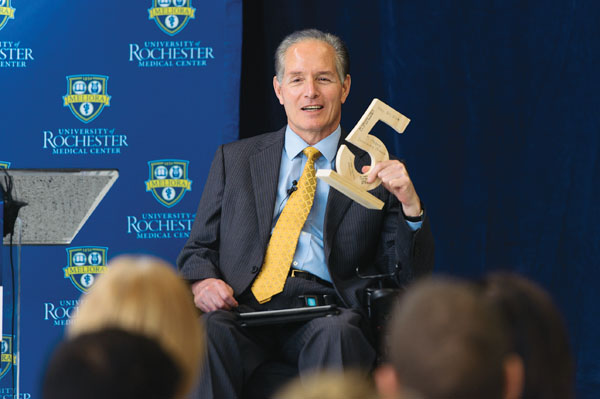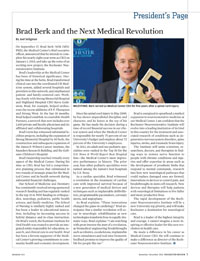President's Page
 MILESTONE: Berk served as Medical Center CEO for five years after a spinal cord injury. (Photo: Brandon Vick)
MILESTONE: Berk served as Medical Center CEO for five years after a spinal cord injury. (Photo: Brandon Vick)On September 17, Brad Berk ’81M (MD/PhD), the Medical Center’s chief executive officer, announced that he intends to complete his nearly eight-year term as CEO on January 1, 2015, and take up the reins of an exciting new project, the Rochester Neurorestorative Institute.
Brad’s leadership at the Medical Center has been of historical significance. During his time at the helm, Brad transformed clinical care into the coordinated UR Medicine system, added several hospitals and providers to this network, and emphasized patient- and family-centered care. Working closely with Strong Memorial Hospital and Highland Hospital CEO Steve Goldstein, Brad, for example, helped orchestrate the recent additions of F. F. Thompson and Strong West. In the last 18 months, Brad helped establish Accountable Health Partners, a network that now includes over 1,600 private and faculty physicians and six affiliated and collaborating hospitals.
Brad’s term has witnessed substantial facilities projects, including the expansion of Strong Memorial Hospital by 80 beds, the construction and subsequent expansion of the James P. Wilmot Cancer Institute, the Saunders Research Building, and the Golisano Children’s Hospital.
Brad’s leadership touched virtually every aspect of the Medical Center. During his time as CEO, Brad has led a comprehensive planning process that culminated in two rounds of strategic plans for the Medical Center and its health network during substantial financial challenges.
Our School of Medicine and Dentistry has consistently received strong sponsored research funding and has regularly ranked in the top 15 in NIH funding in orthopaedics, neurology, pediatrics, public health science, and family medicine. The School of Nursing is similarly highly ranked and has been a leader in educational innovation, including its increasing success in hybrid distance and in-class instruction. On Brad’s watch, the Eastman Institute for Oral Health was created to provide an integrated entity responsible for education, research, and clinical care in oral health. Brad has been a fervent supporter of the Medical Center’s growing commitment to community health and economic development.
Since his spinal cord injury in May 2009, he has shown unparalleled discipline and character, and he leaves at the top of his game. He has made his decision during a time of record financial success in our clinical system and when the Medical Center is responsible for nearly 75 percent of our University’s budget and employs about 72 percent of the University’s employees.
In 2013, six adult and one pediatric specialties were ranked in the Top 50 for the U.S. News & World Report Best Hospital lists—the Medical Center’s most impressive performance in history. The prior year, four other pediatric specialties were ranked among the nation’s best hospitals by U.S. News.
As a cardiac specialist, Brad witnessed a revolution in the treatment of cardiac care with improved survival because of a new generation of medical devices and techniques such as implantable defibrillators, programmable pacemakers, coronary stents, and angioplasty.
As Brad explains: “These innovations changed the game in cardiology.” Brad anticipates that a similar revolution will occur in neurologic rehabilitation as new technologies transform lives in equally dramatic ways. Brad explains: “I am watching with great interest the start of a revolution, as biomedical engineering breakthroughs such as robotics, exoskeletons, implantable nerve stimulators and real-time biometric feedback promise to improve the quality of life for people like me.”
Brad is energized to spearhead a marked expansion in neurorestorative medicine at our Medical Center. I am confident that the Rochester Neurorestorative Institute will evolve into a leading institution of its kind in this country for the treatment and associated research of conditions such as degenerative nervous system disorders, spine injuries, stroke, and traumatic brain injury.
The institute will unite scientists, researchers, doctors, and therapists in finding ways to restore nerve function to people with chronic conditions and injuries and offer expertise in areas such as the development of prosthetic limbs that respond to mental commands, research into how new neurological pathways that could replace damaged ones are formed, innovations in devices to control pain, and breakthroughs in stem cell research. New devices and therapies will help patients with neurological limitations to live fuller and more productive lives.
The rapid development of the Rochester Neurorestorative Institute will be a new University top priority, and will make Rochester a destination for neurological care.
Brad is a leader of the highest integrity and courage. I cannot imagine a more inspiring or effective leader for this new revolution in health care.
He made a difference in his career as Medical Center CEO. He will continue to make a difference as director of the Rochester Neurorestorative Institute.

